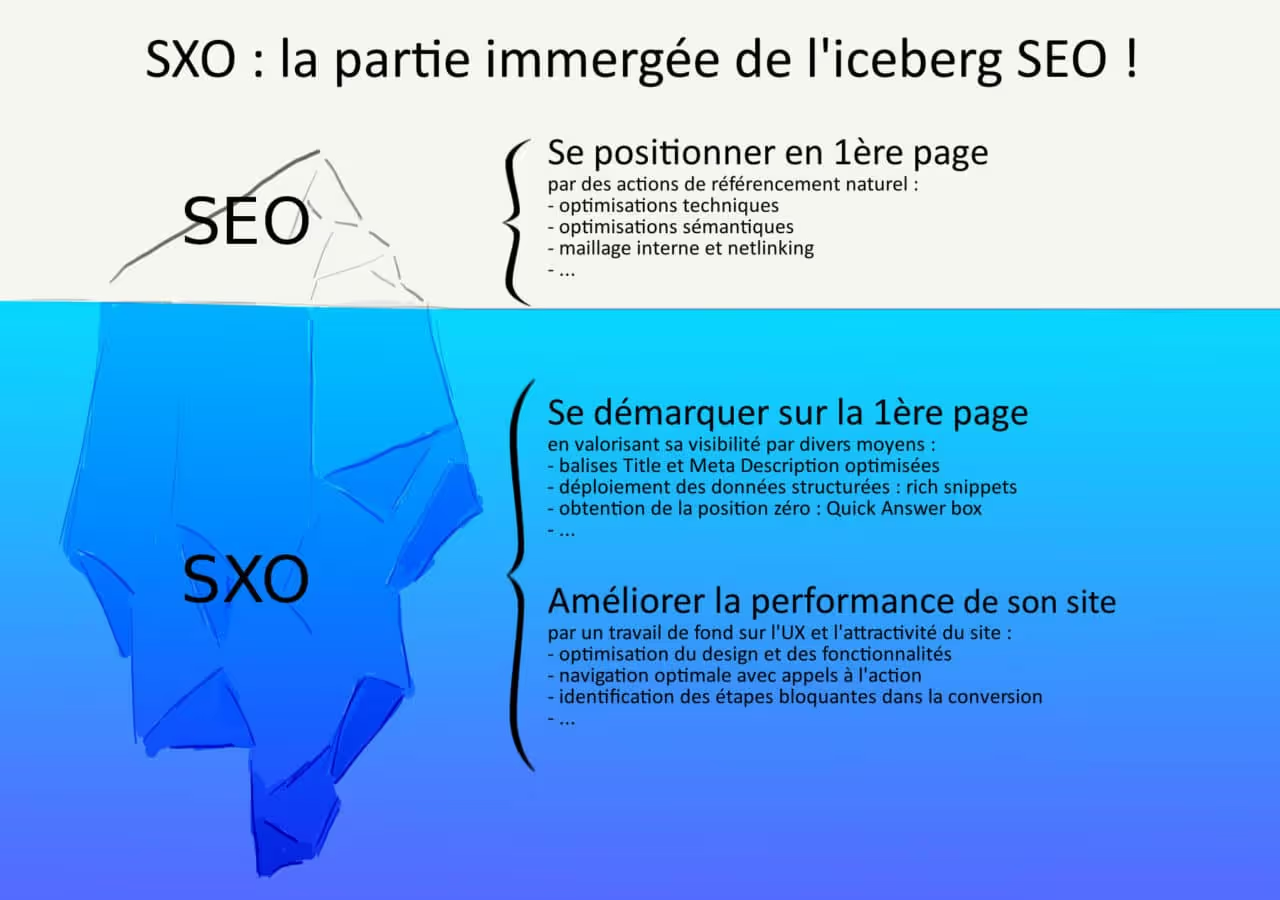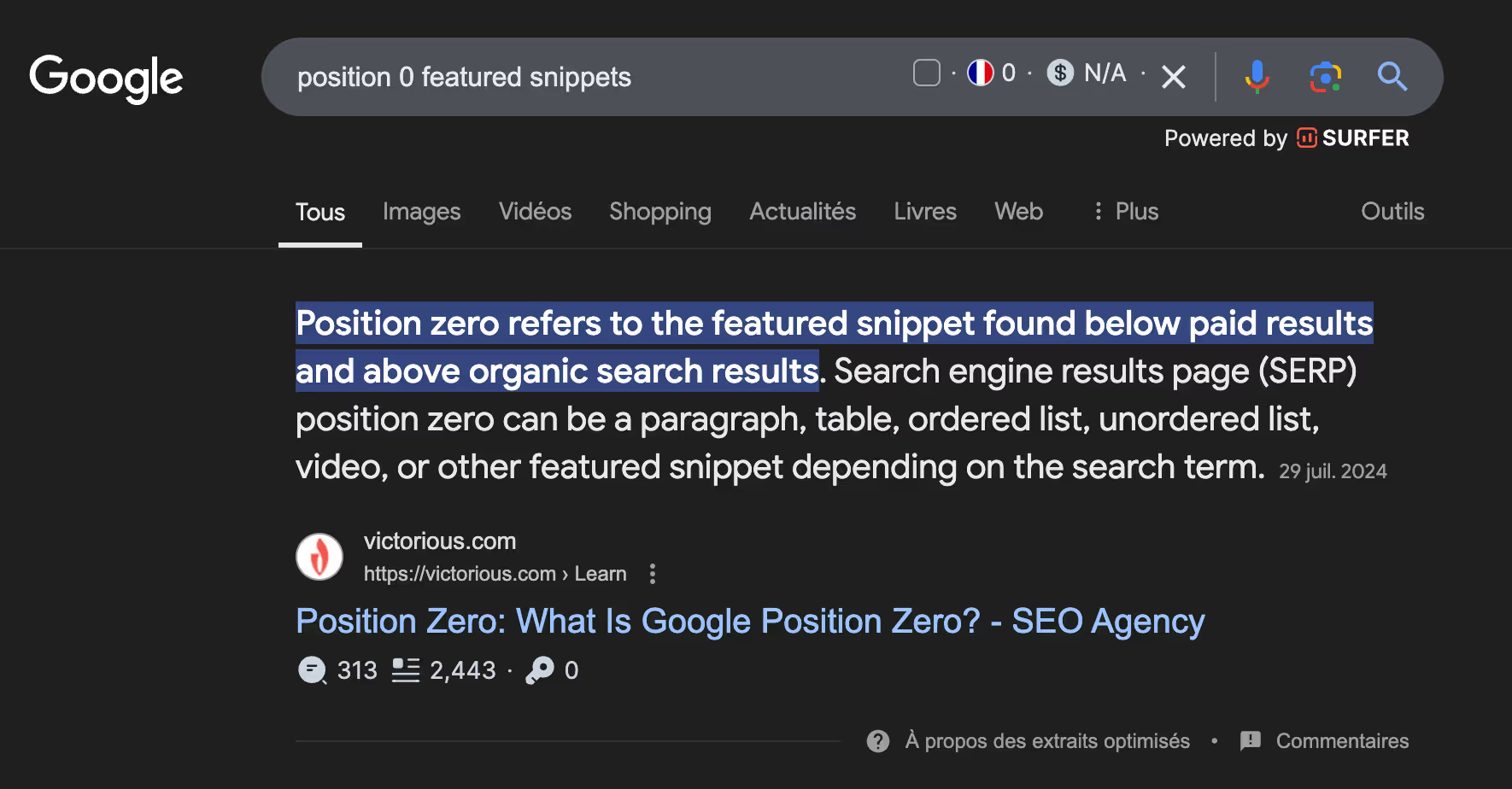SXO (Search eXperience Optimization): The alliance between SEO and UX designed to convert



Natural referencing is evolving. In 2025, generating organic traffic is no longer enough if your visitors leave without acting. Around 68% of online experiences start with a search engine but 61% of users leave a site if the load exceeds 3 seconds (source: Google, 2025).
The SXO (Search Experience Optimization) Solve this equation. More than just an SEO strategy, it integratesoptimizing the user experience (UX) to simultaneously meet the expectations of Google and your visitors. The aim is to turn every click into a conversion, not just a visit.
Brands applying SXO strategies get +200-400% conversions vs classic SEO approach. Our experience at Noqode on Webflow projects confirms these results.. SXO-optimized sites consistently generate 2-3x higher conversion rates.
In this article, discover the precise definition of SXO, its differences with traditional SEO, the pillars of an effective strategy, and our concrete methodology to boost visibility AND business results.
The SXO merges two complementary disciplines:
SXO objective: Satisfy Google algorithms (SERP positioning) AND real users (engagement, satisfaction, conversion). This will not only improve your positions in the search results but above all increase your conversion rate and your visitors as customers.
Google algorithms now include user experience signals as ranking criteria: Core Web Vitals (LCP, FID, CLS), bounce rate, session time, navigation depth, page interactions.
Pages with Core Web Vitals vouchers show 24% lower bounce rate your slow pages. A slow or not very ergonomic site = ranking penalty, even with excellent content.
At the same time, 60% + searches are mobile or voice (source: Vision Ranking, “Why SXO is the Future of Ranking”, August 2025). The SXO responds to these developments via native responsive design, performance optimizations, adapted conversational content, voice assistants.
With a intuitive navigation, Intention-focused relevant content and Strategically placed CTAs, Internet users quickly find what they are looking for, stay longer, act more often: purchase, register, request a quote, download.
The average conversion rate of optimized landing pages = 2.35% But the top 10% reaches 11% +. Critical difference? A comprehensive SXO strategy is rigorously applied.
The SXO = Lever for business growth in its own right, not simple secondary technical optimization.
By adopting SXO, you keep the Best of SEO (optimized title/meta tags, strategic netlinking, relevant keywords, solid technical structure) while improving navigation quality and Relevance content.
It is the winning alliance for sustainable referencing : visibility + engagement + conversions.

Based on our experience on case studies from various business sectors (consulting, finance, training,...) an effective SXO strategy is based on 7 complementary pillars.
Objective: Understand what the user is really looking for, not just the keyword typed in.
Concrete actions:
Noqode example: For article”Showcase site price“, PAA analysis revealed the question “How much does annual maintenance cost?” = no competitor answered it. Add dedicated section = Featured snippet obtained in 6 weeks.
Objective: Make navigation fluid, intuitive, pleasant.
Concrete actions:
Key stats: Pages with Core Web Vitals vouchers = -24% bounce rate.
Noqode example: Site PestControl3D optimized: LCP 4.2s → 1.1s = +50% of qualified leads via contact form.
The core SXO strategy is based on quality content responding precisely to Research intentions and demonstrating Expertise, Experience, Authoritativeness, Trustworthiness (EEAT).
Concrete actions:
Position 0 format (Featured Snippets):
To reach position 0 Google, structure answers in the form of:
Result: +35% CTR vs position #1 classic (source: Ahrefs, “Featured Snippets Study”).

Objective: Transform visitors into leads/customers.
Concrete actions:
Objective: Guarantee that Google can crawl, index, and understand your site.
Concrete actions:
site-webflow-exemple.jpg), precise alt tags, WebP formatObjective: Helping Google and LLMs understand your content
Concrete actions:
Impact: Improve chances featured snippets + conversational AI quotes (ChatGPT, Perplexity, Claude).
Objective: Continuous improvement based on data.
SXO KPIs to follow:
Actions: Looker Studio real-time dashboard, monthly GSC analysis, quarterly heatmaps (Hotjar/Clarity), A/B continuous tests (min 1/month).
Noqode example: Monitoring article”What is the price of a visual identity?“→ detection position #1 reached → winning copywriting analysis → replication strategy on article “Price showcase site” article.
One high conversion rate is based on 4 complementary fundamentals:
By testing different versions (A/B Testing) and measuring performance, you identify the optimal formula for your specific audience.
The SXO brand new era SEO, where user satisfaction becomes as important as standings on Google. By integrating solid SEO practices, ergonomic design, quality content and Effective CTAs, you maximize your chances of succeeding online.
SXO combines better SEO (visibility) + better UX (engagement) = measurable business growth. SXO-optimized sites generate +200-400% conversions vs pure SEO approach according to recent studies. Strategy applicable to all sectors, particularly effective on modern CMS (Webflow, Framer).
Want to take action?
Contact Noqode to discover how we can help you create a fast, beautiful and profitable Webflow website, thanks to an SXO approach designed for your audience and search engines.
The SEO (Search Engine Optimization) focuses on optimizing factors like keywords, Backlinks and Site structure to improve search engine visibility.
The SXO (Search eXperience Optimization) combines these SEO methods with optimizing user experience (UX). Objective: not only to obtain a good ranking, but also to offer smooth navigation to convert more visitors.
The SXO aims to optimize as well standings Search engines that experiment experienced by visitors. By better meeting Internet expectations, you increase satisfaction, Reduce bounce rate and improve conversions (purchase, registration, etc.). It is a key lever for boosting visibility AND business results.
Analyzing research intent: Use tools like Google Search Console to understand user queries.
Structuring articles with clear tags (H1, H2, H3) and short paragraphs for easy reading.
Insert relevant keywords, without falling into over-optimization.
Focus on ergonomics and readability: catchy titles, illustrative images, airy layout.
By adopting best practices, you make content clearer for Internet users... and for Google.
Yes, it is even one of its main objectives. SXO is not limited to seo : it integrates UX quality to guide visitors to the desired action (fill out the form, place an order, etc.).
En streamlining navigation and offering content adjusted to real user needs, you increase engagement and, therefore, conversion probability.
Absolutely. Update or supersede old links by new pages more recent and adapted audience needs reinforces internal networking coherence.
It is positive for user experience (who finds good information more quickly) and for google, which values updated and relevant site.
Quick wins (1-3 months): Technical optimizations (speed, mobile) = immediate results, commitment.
Organic SEO (3-6 months): Content + mesh = progressively improved positions.
SXO maturity (6-12 months): Domain authority + optimal user experience = exponential growth.
Noqode example: Article “Visual identity award” = position #1 reached in 4 months.
Yes, but Effectiveness varies. Heavy CMS (WordPress, Drupal) = complex technical optimizations. Modern CMS (Webflow, Framer) = SXO facilitated (native performance, flexible design).
Noqode recommends Webflow for SXO strategies : Excellent core Web Vitals natively, native responsive design, intuitive content management.
Priority SXO KPIs:
Visibility: Average position, organic traffic
Commitment: Bounce rate, page time, pages/session
Performance: Core Web Vitals (LCP, FID, CLS)
Conversion: Conversion rate, leads generated, sales
Tools: Google Search Console, Analytics 4, PageSpeed Insights, Hotjar.
The 3 classic SEO pillars: (1) Technique (speed, mobile, structure), (2) Contents (keywords, quality, freshness), (3) Popularity (backlinks, domain authority).
The SXO adds 4th pillar: User experience (UX) (usability, conversion), which has become Google ranking factor since Core Web Vitals (2021).
SXO agency = agency combining SEO expertise (referencing) and UX Design (user experience). Unlike a traditional SEO agency, an SXO agency optimizes the complete journey: Google search → site visit → conversion.
Noqode = SXO agency specialized in Webflow, with proven methodology on client projects.